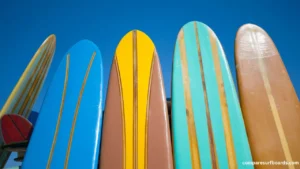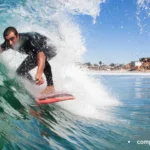Surfing is an art form that fuses the unpredictable force of nature with human skill and technology. At its center lies the surfboard itself and, more specifically, its fin setup which can have dramatic ramifications for performance.
No matter your experience level or skill set, this guide will cover the benefits and drawbacks of four of the most commonly used surfboard fin setups – single fin, twin fin, thruster fins and quad fins.
Surfboard fin setups are more than simply personal preferences; they play an integral part in surfing’s maneuverability, speed, and stability.
The recent proliferation of quad fin setups reflects our quest to strike an optimal balance between control and freedom on the waves.
By providing insights into the distinctive characteristics of each setup, this guide seeks to enhance your surfing experience and enable you to discover new areas of passion.
Contents
- 1 Selecting the Appropriate Fin Setup
- 2 Conclusion:
- 3 FAQs
- 3.1 1. What is the ideal fin setup for beginners?
- 3.2 2. Are different fin setups compatible on one surfboard?
- 3.3 3. How does fin setup influence surfboard performance?
- 3.4 4. Are quad-fin setups appropriate for big waves?
- 3.5 5. What are the ideal conditions for twin fin setups?
- 3.6 6. Why might a surfer prefer single fin configurations over more contemporary arrangements?
Selecting the Appropriate Fin Setup
Fin configuration can make an enormous difference to your surfing, adapting your board to match specific wave conditions, surfing styles, and personal preferences.
Understanding each fin configuration will enable you to make smart decisions and enhance your relationship with the waves.
Surfboard Fin Setups in Four Main Types
The Single Fin, beloved for its simplicity and elegance, brings back memories of surfing’s golden age. Providing exceptional stability and direction control, single fin setups are ideal for longboards but are now finding themselves increasingly used on shorter and mid-length designs as well.
Pros:
- Stability and Control: With its single fin design, this board offers exceptional stability that makes holding onto lines on large waves simpler.
- Smooth Rides: Single fins provide a graceful, flowing experience and are the ideal solution for cruisers who like long turns.
Cons:
- Speed Limitations: Generating speed can be challenging, requiring surfers to rely on wave power more.
Reduced Maneuverability:
Single fin setups may feel less responsive when making quick turns, potentially diminishing maneuverability.
Twin Fins Introduced to add speed and agility into surfing, twin fins offer a dynamic ride characterized by their quickness.
Pros:
- Speed and Liveliness: Twin fins are well known for their speedy ride. Their twin fin design helps create a lively experience quickly.
- Enhance Maneuverability: Our setup enables quick, snappy turns that make small to medium waves enjoyable.
Cons:
- Stability Issues: Twin fins may feel loose and looser during larger waves and aggressive maneuvers, increasing their chance of spinning out and breaking apart.
- Control Challenges: While twin fins can be thrilling to pilot, their unique characteristics can make them challenging for beginners to control.

Thruster Setup
First popularized during the early ’80s, three fin thrusters have since become the standard among professional surfers for their ability to deliver speed, control, and versatility in equal measures.
Pros:
- Thrusters Provide Well-Rounded Performance: Thrusters provide a well-balanced ride suitable for various wave conditions.
- Improved Control: The three-fin configuration enhances stability and control in critical sections of a wave.
Cons:
- (Twin Fins): While thrusters may reach faster top speeds than single fins, their top speeds may still not match up to those achieved with twin fins.
- Potential for Drag: With three fins in the water, there may be some additional drag, which could reduce speed in smaller waves with softer waves.
Quads Fin Setup:
The Quads fin set-up has become one of the most sought-after fin setups due to their speed and agility. Perfect for surfers who favor hard and fast carving techniques.
Pros:
- Quads excel at producing speed effortlessly, making them ideal for fast waves with strong currents.
- Tight Turns: Our setup enables precise pivotal turns without compromising speed.
Cons for Quad Surfers:
- Quad boards may feel less stable than thrusters under certain conditions and require an experienced surfer to navigate safely.
- Limitations in Air Performance: For surfers focused on aerial maneuvers, this board may not be their first choice as its design prioritizes speed and carve over airtime.
Conclusion:
Surfboard fin setups offer something to meet every surfer’s taste and style, providing something special for each surfer’s surfing style and preference.
No matter if it be the classic allure of a single fin, speed and playfulness of twin fin, balance thruster or fast quad; each setup offers unique strengths and weaknesses.
Experimenting with different fin configurations can unlock hidden potential in your surfing, prompting growth and exploration. Remember, the ideal fin setup should bring you joy on the waves; so why not explore some alternatives until you find what suits you best.
FAQs
1. What is the ideal fin setup for beginners?
Beginners often opt for three-fin thruster setups as they provide the optimal combination of stability, control, and maneuverability. Thrusters offer a comfortable ride to help new surfers hone their skills while remaining adaptable as their skills advance.
2. Are different fin setups compatible on one surfboard?
Yes, many modern surfboards feature fin boxes to allow interchangeable fin setups. This means you can switch between single, twin, thruster, and quad fin setups depending on the board design and fin boxes available to it. Some surfboards may only support specific setups which may limit this flexibility.
3. How does fin setup influence surfboard performance?
Fin setup can have a dramatic effect on a surfboard’s turning radius, stability, speed and ability to hold its line on waves. Single fins offer an ideal classic ride with excellent stability; twin fins offer fast turns; thrusters offer balanced rides in various conditions; while quad fins deliver incredible speed with tight turns and quick acceleration.
4. Are quad-fin setups appropriate for big waves?
Quad fin setups can be excellent choices for big waves. Their exceptional speed and tight turning abilities can help navigate large, powerful surf more effectively; their speed helps catch fast-moving waves more effectively while their agility enables quick adjustments on the wave face.
5. What are the ideal conditions for twin fin setups?
Twin fin setups excel in smaller to medium-sized waves, where their speed and maneuverability can be fully utilized. Twin fin setups provide surfers with an enjoyable surfing experience with quick turns that generate speed in softer wave conditions. When choosing your twin fin setup make sure it complements the type of surfing you do by adding playful turns or maneuvering quickly through soft conditions for added speed generation.
6. Why might a surfer prefer single fin configurations over more contemporary arrangements?
Surfers often opt for single fin setups because of their nostalgic appeal and unique riding experience. Single fins encourage a smooth, flowing style and are especially suitable for longboarders who like drawing out turns and cruising the wave, as well as big wave surfers due to their stability.








